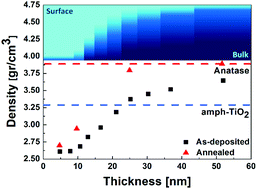Retention of surface structure causes lower density in atomic layer deposition of amorphous titanium oxide thin films
Abstract
Size effects and structural modifications in amorphous TiO2 films deposited by atomic layer deposition (ALD) were investigated. As with the previously investigated ALD-deposited Al2O3 system we found that the film's structure and properties are strongly dependent on its thickness, but here, besides the significant change in the density of the films there is also a change in their chemical state. The thin near-surface layer contained a significantly larger amount of Ti+3 species and oxygen vacancies relative to the sample's bulk. We attribute this change in chemistry to the ALD specific deposition process wherein each different atomic species is deposited in turn, thereby forming a “corundum-like” structure of the near-surface layer resembling that found in the Al2O3 system. This, combined with the fact that each deposited layer starts out as a surface layer and maintains the surface structure over the next several following deposition cycles, is responsible for the overall decrease in the film density. This is the first time this effect has been shown in detail for TiO2, expending the previously discovered phenomenon to a new system and demonstrating that while similar effects occur, they can present in different ways for oxide systems with different structures and symmetries.



 Please wait while we load your content...
Please wait while we load your content...